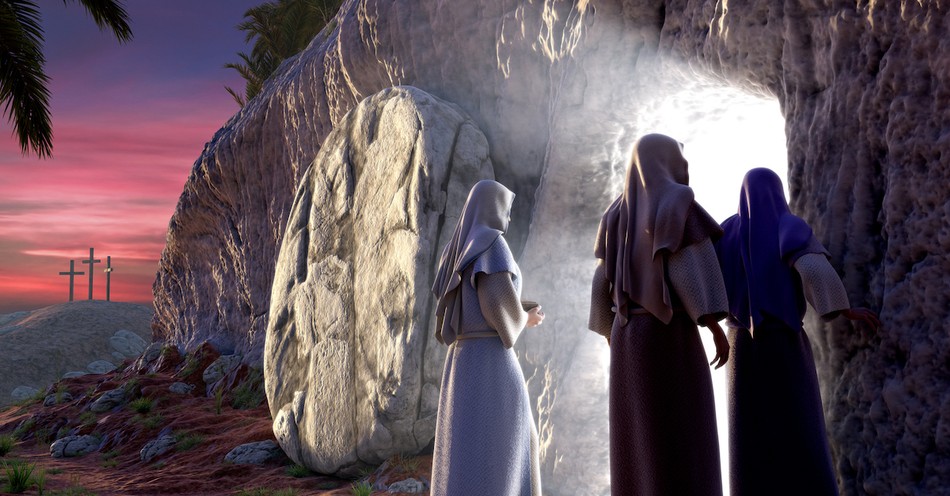The four Gospel writers present the strongest case for the reality of Jesus’ death and resurrection. These Gospels each give a detailed description of where Jesus was buried and important conversations between Jesus and his closest followers before and after Jesus’ death. The similarity of the crucifixion narratives—and support from ancient secular texts and archeological remnants, such as coins engraved with names of Caesars and Herods—strongly suggests that the Biblical description of Jesus’ burial site and tomb is historically and spiritually accurate.
To better understand where Jesus was buried and the location of His tomb, it's important to understand the events around Good Friday and Holy Saturday.
Who Took Jesus’ Body After He Died?
After Jesus dies on the cross, Joseph of Arimathea, a wealthy Jewish council member, asks Pilate for Jesus’ body (Mark 15:43). His request is granted. Joseph gives Jesus a proper burial. Matthew 27:59-60 says “Joseph took the body, wrapped it in a clean linen cloth, and placed it in his own new tomb that he had cut out of the rock. He rolled a big stone in front of the entrance to the tomb and went away.”
Before placing Jesus’ body in the tomb, Joseph and Nicodemus quickly embalm His body with expensive spices (John 19:38-40). As with all work, burial preparations must be finished before sunset on the Jewish sabbath.
In a National Geographic article on the apparent discovery of Jesus’ tomb, an archeologist says, “All of this is perfectly consistent with what we know about how wealthy Jews disposed of their dead in the time of Jesus . . . This does not, of course, prove that the event was historical. But what it does suggest is that whatever the sources were for the gospel accounts, they were familiar with this tradition and these burial customs.”
Joseph of Arimathea’s respectful burial of Jesus’ remains is consistent with the prophet Isaiah’s prediction for Christ’s burial: “His grave was assigned with wicked men, Yet He was with a rich man in His death, Because He had done no violence, Nor was there any deceit in His mouth” (Isaiah 53:9).
Usually, an executed criminal’s body in the Roman empire was dumped in a trench for wild animals to scavenge and the left-over flesh to rot (see the NIV Study Bible footnote to Luke 23:52). Jesus was entombed in rock, and Pontius Pilate honored the chief priests’ and Pharisees’ request to seal Jesus’ tomb with a large stone. The members of the Jewish Sanhedrin believed the stone and a guard were needed to prevent Jesus’ followers from stealing the body in a mock resurrection (Matthew 27:62-66).
Does the Bible Say Where Jesus Was Buried? Is His Tomb at The Church of the Holy Sepulcher?
The gospels tell us that Joseph entombed Jesus in “a garden and in the garden a new tomb… since the tomb was nearby.” That is, the tomb was near Golgotha (John 19:41). The dead were buried outside the city walls in first-century Jerusalem. The description of Jesus’ burial site in the gospel of John is consistent with the discovery by a team of archeologists of a tomb surrounded by the Church of the Holy Sepulcher in Jerusalem’s Old City in 2016. The Church of the Holy Sepulcher is about 500 feet south and 350 feet east of the ancient city wall of Jerusalem, built by Herod Agrippa ten or fifteen years after Jesus’ crucifixion. This location surrounding the tomb has been a crowded urban area since the fourth century. When Jesus was buried in 30 A.D., this area was outside the city.
Archeologists believe the area also contains the remains of a temple dedicated to the Roman goddess Venus, built by the Roman emperor Hadrian around 125 A.D. to assert Roman authority over a religious, Christian site. The Jewish community in Jerusalem had preserved the memory of Jesus’ crucifixion and burial. Three hundred years later, in about 325 A.D., Constantine, the first Christian emperor of Rome, built the church of the Holy Sepulcher in the same place to enclose the tomb believed to house Jesus’ body. Constantine’s troops built a rotunda around Jesus’ tomb and, on the other side of the Holy Garden, a basilica with side aisles where people could pray. Between the rotunda and the basilica is the hill of Golgotha or Calvary, where Jesus was crucified.
Regarding this as the location for where Jesus was buried, an archeologist quoted in the National Geographic article “Unsealing of Christ’s Reputed Tomb Turns Up New Revelations,” states, “We may not be absolutely certain that the site of the Holy Sepulcher Church is the site of Jesus’ burial, but we certainly have no other site that can lay a claim nearly as weighty, and we really have no reason to reject the authenticity of the site.”
What Happened After Jesus Was Buried?
Women followers of Jesus—Mary Magdalene, Mary the mother of James, and Salome among them—take spices to embalm Jesus’ body on the third day after His burial. The women find the tomb empty and wonder who moved the stone (Luke 24:1-2). An angel appears and tells the women, “Do not be afraid, for I know that you are looking for Jesus, who was crucified. He is not here; he has risen, just as he said. Come and see the place where he lay. Then go quickly and tell his disciples” (Matthew 28:2-10). Peter and two other disciples run to witness the empty tomb. They leave, puzzled. Then, Jesus, Himself appears at the tomb and tells weeping Mary Magdalene that He has risen from the dead. Mary runs to share the good news with the disciples: “I have seen the Lord!” (John 20:10-18). This sabbath morning is now observed as Easter in the Christian calendar.
What Were the Events Around Jesus' Death?
Matthew 26:57-67 describes Jesus’ arrest, trial, and death penalty for calling Himself the Christ, the son of God. Jesus incriminates himself by stating this “blasphemy” before the high priest Caiaphas (Matthew 26:57). Caiphas’ skeletal remains were reportedly discovered inside an ornate limestone box in the old city area of Jerusalem in 1990.
Caiaphas followed the Roman legal code, which had appointed him a high priest: a punishment by death for threatening Caesar’s authority (John 19:12). Jewish law also decreed that anyone claiming to be the Son of God must die (John 19:7, 15). Romans and Jews in the angry mob gathered at Jesus’ hearing, insisting Pontius Pilot crucify Jesus.
In the culture of the Roman Empire, accused criminals received rough treatment before and after their death. Jesus is spit on, struck with fists, slapped, and mocked by Roman soldiers before His crucifixion (Matthew 26:67; John 19:31a). Passersby and leaders of the Jewish Sanhedrin—the high court of priests, teachers, and lawyers who had attended Jesus’ hearing (Luke 22:66)—insult Jesus as he suffers crucifixion on the cross at Golgotha (or Calvary).
The observance of the Jewish Passover is in the backdrop of the gospels’ account of Christ’s crucifixion. Pilate rushes legal procedures so that Jewish citizens can attend the Passover feast (John 18:28-29). The Friday of Christ’s crucifixion is referred to as Preparation Day before the Passover, the Saturday sabbath (Luke 23:54; John 19:31). The Jewish community goes on with its celebration of Passover during the days that Christ is tried, crucified, and buried.
Was the Empty Tomb of Jesus a Miracle?
Today, the empty tomb is accepted with little question by Christians and is a core tenet of our faith. Easter is the highlight of the Christian year. Yet people have attempted to cover up the truth of the resurrection from the time of Jesus’ burial. Matthew 28:11-15 describes how Jewish chief priests and elders pay Roman guards “a large sum of money” on what we now know as Easter morning so that the guards will tell the governor Pilate, “His disciples came during the night and stole him away while we were asleep.” Matthew also reports, “this story has been widely circulated among the Jews to this very day.”
Besides Bible documentation of Jesus rising from the dead and leaving the tomb empty, the Jewish community in Jerusalem kept alive the story of the death and resurrection of Jesus. Jews would know his actual burial site. The truth would have begun circulating when Jesus’ closest followers saw him in the days after His burial and listened to him tell how He fulfilled the prophecy of God that had been part of the Jewish faith since Old Testament days. In addition to the eyewitness accounts of Mary Magdalene, Mary, the mother of Jesus, the twelve disciples, and others, Paul writes in 1 Corinthians 15:6, “After that, He appeared to more than five hundred of the brothers at the same time, most of whom are still living.” Many eyewitnesses visited the empty tomb, and some were blessed by seeing Christ after his resurrection.
Doubters have developed alternative theories to explain away the empty tomb. One of these theories is that the women and disciples ran to the wrong tomb in their excitement. This theory goes against all of the gospel narratives. The women walked solemnly to Jesus’ tomb. The women most likely told the disciples the tomb’s location, or the disciples knew from two days earlier where Christ was buried. Most significantly, the empty tomb validates the fulfillment of scripture, Old Testament and New Testament, in the life of Jesus’ followers.
The apostle Paul repeats a creed that Bible scholars believe was written within two decades of Jesus’ death and resurrection:
For what I received I passed on to you as of first importance: that Christ died for our sins according to the Scriptures, that he was buried, that he was raised on the third day according to the Scriptures, and that he appeared to Cephas, and then to the Twelve. 1 Corinthians 15:3-5
Photo Credit: ©GettyImages/jgroup

Learn more about the meaning and significance behind the Easter holiday and Holy Week celebrations:
What is Lent? and When Does Lent Start?
What is Ash Wednesday? and When is Ash Wednesday?
What is Palm Sunday?
What is Maundy Thursday?
What is Good Friday? and When is Good Friday?
What is Holy Saturday?
What is Easter? and When is Easter Sunday?
Easter Bible Verses
The Resurrection of Jesus
Easter Prayers

_639003522088907085.jpg)

